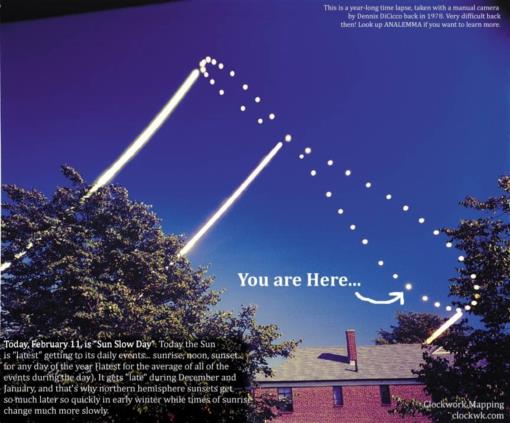
NavList:
A Community Devoted to the Preservation and Practice of Celestial Navigation and Other Methods of Traditional Wayfinding
From: Frank Reed
Date: 2021 Feb 9, 11:31 -0800
Thursday is Sun Slow Day. This is the day when the Sun falls farthest behind mean time. Even the Sun doesn't want to get out of bed. It's cold and dreary here in mid-northern latitudes so the Sun sleeps in. It won't be roused until more than 14 minutes later than its mean time alarm goes off. The Sun will be 14.2 minutes late to sunrise, 14.2 minutes late to the meridian at local noon, and 14.2 minutes late to sunset. I am trying to arrange a holiday on this date guaranteeing that anyone can be 14 minutes late on Sun Slow Day. It seems only fair.
In Dennis DiCicco's famous analemma photo below, the Sun Slow portion of the analemma trails on the lower left.
The equation of time curve is very flat on this date so the exact instant of "Sun Slowest time" on "Sun Slow Day" is not well-defined, but this year it's around 1am Eastern US time on Thursday (or late Wednesday night if you stay up after midnight), which is about 0600 UT. At that time the GHA of the Sun will be 266.4477° which is behind the (fictitious) Mean Sun by 3.5523°, which is as far east of the Mean Sun as it gets this year. At the usual rate of 1° in four minutes, this is equivalent to 14m 12.6s slow. The equation of time is within 1 second of that low for over 24 hours on either side of the minimum.
There's a lof of catching up to do if the Sun is going to finish its taxes on time (a US reference to federal tax due date). The equation of time will be all the way back to zero on about April 15. On that date the GHA of the Sun will match the ideal Mean Sun: nearly zero, right on the prime meridian, at 1200 GMT and incremented almost exactly 15° for every hour after that.
Frank Reed








